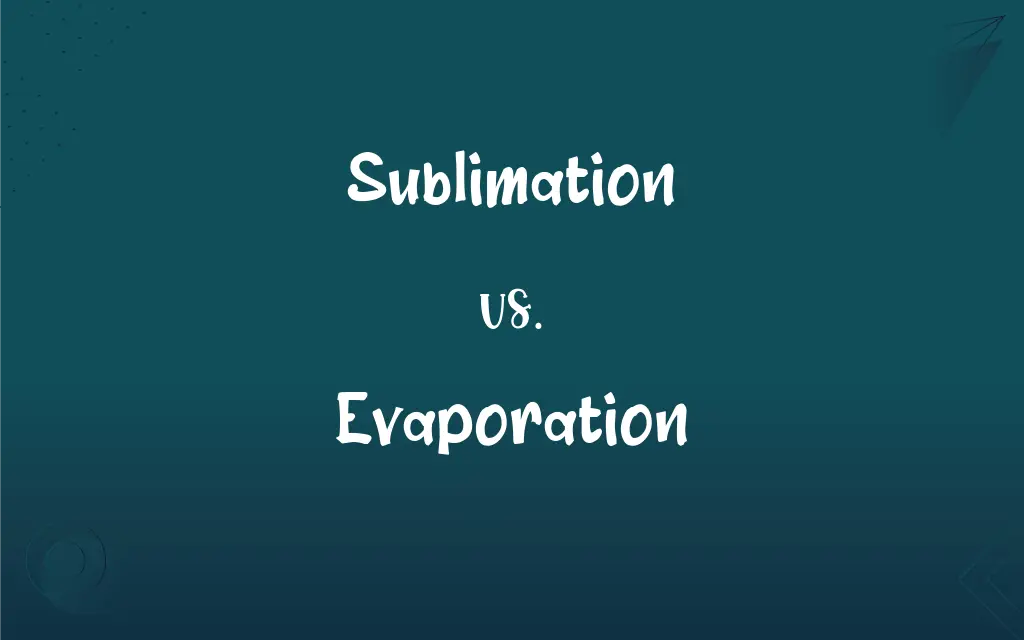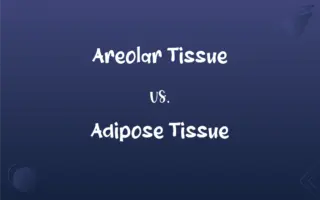Sublimation vs. Evaporation: What's the Difference?
Edited by Aimie Carlson || By Harlon Moss || Updated on October 10, 2023
Sublimation is the process of a solid turning into a gas without passing through a liquid state, while evaporation is the transformation of a liquid into a gas at a temperature below its boiling point.

Key Differences
Sublimation and evaporation are two distinct processes, even though they both involve a phase change. Sublimation refers to the transition of a substance directly from the solid to the gas phase without passing through the intermediate liquid phase. This process is endothermic, meaning it absorbs heat from the surrounding environment, and is frequently observed in dry ice (solid CO2) and frozen water under certain conditions.
On the other hand, evaporation is a surface phenomenon where molecules from a liquid phase gain enough energy to become gas. This happens when particles at the surface of the liquid absorb enough energy to break the intermolecular forces that hold them in the liquid state. In contrast to sublimation, evaporation does not require the substance to be in a solid state and instead operates from the liquid phase, occurring at temperatures below the boiling point of the liquid.
Sublimation can often be witnessed in everyday phenomena like the disappearance of ice or snow without any apparent melting, showcasing a direct transition from solid to vapor. Evaporation, by contrast, is visible when water in an open container slowly disappears over time, transforming from liquid to vapor at ambient temperature, significantly below its boiling point of 100 degrees Celsius.
In an experimental context, the difference between sublimation and evaporation is often exploited. Sublimation can be utilized in processes like freeze-drying, where a substance is frozen and then the ice is sublimated in a vacuum, thus removing water and preserving the dried substance. Meanwhile, evaporation can be used in methods like distillation, where a liquid is turned into vapor to separate mixtures based on different boiling points.
Understanding sublimation and evaporation is crucial in various scientific and industrial fields. For instance, sublimation is leveraged in manufacturing processes, such as the creation of sublimation prints on fabric, which involves transferring dye from a solid state to a gaseous state to permeate the material. In contrast, evaporation is fundamental in processes like the water cycle, where water bodies provide vapor to the atmosphere, ultimately contributing to precipitation.
ADVERTISEMENT
Comparison Chart
Phase Change From
Solid
Liquid
Phase Change To
Gas
Gas
Intermediate Phase
No
Yes (not passed through but exists)
Energy Requirement
Generally high
Lower than boiling point
Common Occurrence
Dry ice sublimating, frost disappearing
Water disappearing from open containers
ADVERTISEMENT
Sublimation and Evaporation Definitions
Sublimation
Sublimation is the direct transition of a solid to a gas without becoming liquid.
The dry ice emitted a cloudy vapor as it underwent sublimation.
Evaporation
Evaporation is a surface phenomenon primarily occurring at the liquid’s surface.
The slow evaporation of water from the lake contributes to cloud formation.
Sublimation
Sublimation can be utilized in freeze-drying processes for preservation.
Through sublimation, the scientists preserved the bacteria in a state suitable for long-term storage.
Evaporation
Evaporation is the process where liquid turns into vapor without reaching its boiling point.
The puddle gradually disappeared through evaporation under the hot sun.
Sublimation
Sublimation involves the absorption of heat without passing through a liquid phase.
The snow on the mountain peaks vanishes via sublimation on sunny days.
Evaporation
Evaporation occurs when particles in a liquid gain enough energy to convert into a gas.
Evaporation of sweat from the skin surface helps in cooling the body.
Sublimation
Sublimation can occur under specific pressure and temperature conditions.
At high altitudes, the frost undergoes sublimation due to the low atmospheric pressure and direct sunlight.
Evaporation
Evaporation can happen at any temperature when a liquid is exposed to air.
Even on a chilly day, evaporation occurs, albeit at a reduced rate.
Sublimation
Sublimation is an endothermic process requiring energy to change state.
In a vacuum chamber, the frozen strawberries experienced sublimation, turning to vapor without melting first.
Evaporation
Evaporation contributes significantly to the water cycle in the environment.
Evaporation from the ocean surfaces plays a vital role in weather patterns.
Sublimation
To be transformed directly from the solid to the gaseous state or from the gaseous to the solid state without becoming a liquid.
Evaporation
To convert or change into a vapor.
Sublimation
(Chemistry) To cause (a solid or gas) to sublimate.
Evaporation
To draw off in the form of vapor.
FAQs
What is sublimation?
Sublimation is the direct transformation of a solid into a gas without passing through a liquid phase.
What is a practical application of sublimation in technology?
Sublimation is used in freeze-drying technology to preserve perishable materials.
How does temperature affect evaporation?
Higher temperatures increase evaporation by providing more energy to liquid particles.
What is the main factor driving evaporation?
The main factor driving evaporation is the kinetic energy of the liquid particles.
Does evaporation always lead to precipitation in the water cycle?
Not always, evaporated water may re-condense or continue as water vapor in the atmosphere.
What is a common example of sublimation?
A common example of sublimation is the transition of dry ice (solid CO2) directly into carbon dioxide gas.
What is evaporation?
Evaporation is the conversion of a liquid into vapor without the liquid reaching its boiling point.
Can evaporation cool down a surface?
Yes, evaporation absorbs heat, cooling the remaining liquid and the surface from which it evaporates.
Can evaporation occur below freezing temperatures?
Yes, evaporation can occur at any temperature, though it is slower at lower temperatures.
Does wind speed affect evaporation rate?
Yes, higher wind speeds can enhance evaporation by dispersing the vapor, reducing local humidity.
Why is sublimation relevant in the study of extraterrestrial bodies?
Sublimation is relevant because it explains phenomena like the generation of cometary tails.
Can sublimation occur in a vacuum?
Yes, in a vacuum, sublimation can occur readily due to the absence of atmospheric pressure.
Can sublimation occur at room temperature?
Yes, sublimation can occur at room temperature for certain substances, like dry ice.
Does pressure affect sublimation?
Yes, reduced pressure can facilitate sublimation by lowering the energy required for the phase change.
How does surface area impact evaporation?
A larger surface area allows for faster evaporation due to increased exposure of liquid to air.
Is it possible to observe sublimation in everyday life?
Yes, sublimation can be observed in phenomena like dry ice vaporizing and frost disappearing.
Are sublimation and deposition opposite processes?
Yes, sublimation and deposition are opposite; sublimation is solid to gas, deposition is gas to solid.
Can all liquids evaporate?
All liquids can evaporate to some degree; however, the rate and conditions vary widely.
What determines the rate of sublimation?
The rate of sublimation is influenced by factors like temperature, pressure, and surface area.
Is sublimation an endothermic or exothermic process?
Sublimation is endothermic, as it absorbs heat from the surroundings.
About Author
Written by
Harlon MossHarlon is a seasoned quality moderator and accomplished content writer for Difference Wiki. An alumnus of the prestigious University of California, he earned his degree in Computer Science. Leveraging his academic background, Harlon brings a meticulous and informed perspective to his work, ensuring content accuracy and excellence.
Edited by
Aimie CarlsonAimie Carlson, holding a master's degree in English literature, is a fervent English language enthusiast. She lends her writing talents to Difference Wiki, a prominent website that specializes in comparisons, offering readers insightful analyses that both captivate and inform.































































